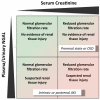Neutrophil gelatinase-associated lipocalin: pathophysiology and clinical applications
- PMID: 23375078
- PMCID: PMC3979296
- DOI: 10.1111/apha.12054
Neutrophil gelatinase-associated lipocalin: pathophysiology and clinical applications
Abstract
Neutrophil gelatinase-associated lipocalin (NGAL), a 25 kDa protein produced by injured nephron epithelia, is one of the most promising new markers of renal epithelial injury. In contrast to serum creatinine and urinary output, which are the measures of kidney function, NGAL is specifically induced in the damaged nephron and then released into blood and urine, where it can be readily measured. Careful proof-of-concept studies using defined animal models have uncovered the sources and trafficking of NGAL in acute kidney injury (AKI) and have addressed the contributions of renal and non-renal sources. Clinical studies indicate that NGAL, unlike creatinine, is a marker responsive to tissue stress and nephron injury, but less so to adaptive hemodynamic responses. In certain clinical settings, NGAL is an earlier marker compared with serum creatinine. In addition, clinical studies have shown that NGAL is a powerful predictor of poor clinical outcomes, which can be used to risk stratify patients when combined with serum creatinine. NGAL has important limitations, including its responsiveness in systemic inflammation, which is partially uncoupled from its response to kidney injury and which needs to be considered when interpreting NGAL results clinically. This review covers the biology and pathophysiology of NGAL and summarizes the results of the growing body of clinical studies that have addressed the utility of NGAL in the early diagnosis of AKI, in the distinction of intrinsic AKI and in the prognostic assessment of broad patient populations.
© 2013 The Authors Acta Physiologica © 2013 Scandinavian Physiological Society.
Figures



References
-
- Bachorzewska-Gajewska H, Malyszko J, Sitniewska E, Malyszko JS, Dobrzycki S. Neutrophil-gelatinase-associated lipocalin and renal function after percutaneous coronary interventions. Am. J. Nephrol. 2006;26:287–292. - PubMed
-
- Bagshaw SM, Bennett M, Haase M, Haase-Fielitz A, Egi M, Morimatsu H, D’amico G, Goldsmith D, Devarajan P, Bellomo R. Plasma and urine neutrophil gelatinase-associated lipocalin in septic versus non-septic acute kidney injury in critical illness. Intensive Care Med. 2010;36:452–461. - PubMed
-
- Bao G, Clifton M, Hoette TM, Mori K, Deng S-X, Qiu A, Viltard M, Williams D, Paragas N, Leete T, Kulkarni R, Li X, Lee B, Kalandadze A, Ratner AJ, Pizarro JC, Schmidt-Ott KM, Landry DW, Raymond KN, Strong RK, Barasch J. Iron traffics in circulation bound to a siderocalin (Ngal)-catechol complex. Nat. Chem. Biol. 2010;6:602–609. - PMC - PubMed
-
- Barresi V, Reggiani-Bonetti L, Di Gregorio C, Vitarelli E, Ponz De Leon M, Barresi G. Neutrophil gelatinase-associated lipocalin (NGAL) and matrix metalloproteinase-9 (MMP-9) prognostic value in stage I colorectal carcinoma. Pathol. Res. Pract. 2011;207:479–486. - PubMed
Publication types
MeSH terms
Substances
Grants and funding
LinkOut - more resources
Full Text Sources
Other Literature Sources
Miscellaneous

